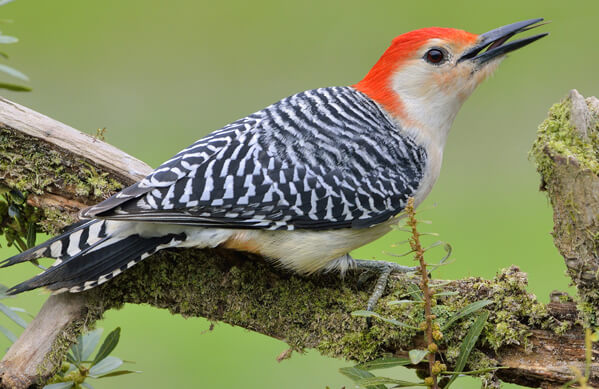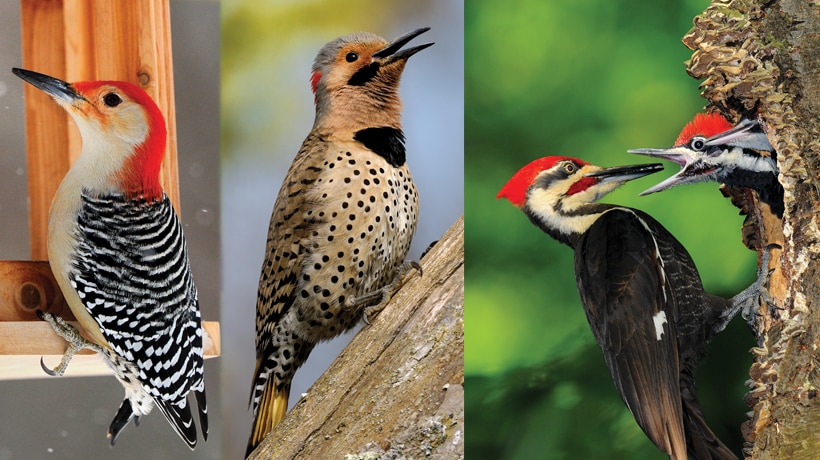Woodpeckers: A Comprehensive Overview to Understanding These Unique Birds
Woodpeckers, with their distinct behaviors and physical characteristics, have actually long astounded the interest of ornithologists and nature fanatics alike. From their rhythmic drumming resembling with the woods to their amazing adaptations for scaling tree trunks with convenience, these birds provide a remarkable research study in bird biology. However, what really sets woodpeckers apart is not simply their striking appearance but also their vital duty in maintaining the fragile balance of ecosystems. As we discover the elaborate composition, varied types, and ecological significance of woodpeckers, a deeper recognition for these one-of-a-kind birds and the mysteries they hold unfolds.

Woodpeckers' Drumming Habits
Woodpeckers show a rhythmic and accurate drumming habits that serves numerous necessary functions in their day-to-days live. This habits is mostly associated with communication, region defense, and foraging. The distinctive drumming audio is produced by the fast pecking of their beaks versus difficult surfaces such as tree trunks, branches, or also steel items.
Communication is a critical facet of woodpecker behavior, and drumming plays a substantial duty in this process. Woodpeckers utilize drumming to develop their visibility, draw in mates, and keep contact with their partners and spawn. The regularity, intensity, and period of drumming sequences share certain messages to other woodpeckers in the location.
Along with communication, woodpeckers make use of drumming actions for region protection. Woodpeckers in Florida. The loud and repeated drumming offers as an alerting to potential burglars, signaling that the location is currently declared. By developing their region with drumming, woodpeckers lower the possibility of conflicts over valuable sources such as food and nesting sites
In addition, woodpeckers additionally utilize drumming as a foraging strategy. The balanced pecking aids them situate bugs concealing below the bark of trees by creating vibrations that interfere with the prey's camouflage. This actions showcases the flexibility and resourcefulness of woodpeckers in utilizing their drumming skills for multiple necessary objectives.
Special Adaptations for Tree Climbing
Having grasped the art of drumming to connect, protect region, and forage, woodpeckers have developed unique adaptations that promote their amazing climbing up capacities in their arboreal habitats. Woodpeckers have zygodactyl feet, with two toes pointing forward and 2 toes aiming in reverse. These tail feathers offer security and equilibrium, making it possible for woodpeckers to navigate up tree trunks with precision and agility.
Additionally, woodpeckers have effective neck muscular tissues and an one-of-a-kind head framework that aid in their climbing up capacities. Their strong neck muscle mass permit them to quickly eat tree bark without experiencing whiplash, while their thick skull and little brain act as shock absorbers, shielding them from the influence of repeated drumming. These adjustments jointly make it possible for woodpeckers to navigate the upright world of trees with efficiency and poise.

Function of Woodpeckers in Ecosystems
Playing a critical function in forest communities, woodpeckers add significantly to the balance and health and wellness of their environments through their distinct actions and interactions with other types. One of the crucial eco-friendly functions of woodpeckers is their function in controlling insect populaces. By foraging for bugs under the bark of trees, woodpeckers help manage bug populations, stopping outbreaks that could harm the general wellness of the woodland. Furthermore, woodpeckers create cavities in trees that act as important nesting sites for a variety of various other bird varieties, advertising biodiversity within the environment.
Additionally, the drumming and vocalizations of woodpeckers play a vital function in interaction and territory facility. These sounds not just offer to attract companions however also aid specify borders in between different woodpecker territories, decreasing disputes and promoting a harmonious coexistence within the woodland neighborhood. Generally, the presence of woodpeckers in forest communities highlights their relevance as keystone varieties, affecting the dynamics and functioning of these environments in complex ways.
Anatomy: Specialized Beaks and Feet
In click here to read the complex web of forest environments, the specialized beaks and feet of woodpeckers are necessary adjustments that allow them to accomplish their critical environmental duties. Woodpeckers have unique anatomical attributes that are specifically designed to assist them in their foraging and nesting habits.
One of the most unique attribute of woodpeckers is their solid, chisel-shaped beaks. These beaks you can try here are flawlessly adapted for exploration into timber to reveal insects, larvae, and sap concealed below the bark of trees. The strong muscles and sturdy structure of their beaks enable woodpeckers to peck at a rate of approximately 20 times per second without creating damage to their heads.
In addition, woodpeckers have actually specialized feet that aid in their acrobatic climbing capabilities. Their feet have 2 toes directing ahead and two toes pointing backwards, supplying a solid grip on upright surface areas (Woodpeckers in Florida). This one-of-a-kind foot arrangement, in addition to rigid tail feathers that act as an encouraging prop, permits woodpeckers to hold on to tree trunks and branches effortlessly while they search for food or excavate nesting dental caries
Woodpecker Variety Variety
Woodpeckers are a diverse team of birds discovered across numerous ecosystems worldwide, with over 200 recognized varieties exhibiting adjustments to different environments. Woodpeckers have actually advanced to live in a range of environments, from forests and woodlands to grasslands and deserts, each presenting special challenges that have affected the evolution of distinct woodpecker types.
Another contributing element to woodpecker varieties variety is their specialized feeding actions. Various varieties have developed to make use of various food resources, such as insects, tree sap, fruits, and nuts, causing the growth of particular adjustments in beak form, size, and strength. These adaptations make it possible for woodpeckers to forage efficiently in their corresponding habitats, decreasing competitors among types and advertising particular niche differentiation. Furthermore, geographic isolation and historical elements have contributed in forming the circulation and variety of woodpecker varieties, leading to the broad array of specialized adaptations seen in these remarkable birds.

Final Thought
In verdict, woodpeckers are interesting birds that exhibit distinct drumming behavior, specialized adjustments for tree climbing, and play important duties in environments. With a varied range of woodpecker types discovered worldwide, these birds are necessary for preserving the health and balance of woodlands visit this web-site and woodlands.